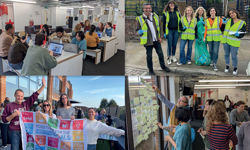There’s an old joke that has an Englishman lost in Ireland. He approaches an old Irishman leaning on a gate and asks him, “My good man, how do I get to Ballygobackwards?” The Irishman answers, “Well, I wouldn’t start from here.” In some ways, the evolution of Global Cement to where it finds itself today is a reflection of that very same journey. But here we are.
Getting started
The early precursor of Global Cement was entitled Asian Cement, founded by myself and a business partner way back in 1996, just before the Asian Crisis. We had six good months of advertising sales before the bottom dropped out of the market in Asia, and we had to start thinking about diversification. Indeed, we launched a series of geographically-focused magazines about the cement industries of the Americas, the Middle East and of Europe. Just to remind you – in case you had forgotten - cement is the grey powder, made in big factories, that you find in sacks in B&Q. You can use cement to make concrete (just add sand, aggregate and water) and it is actually concrete that you find in so-called cement-mixer lorries on the roads: you use concrete to make bridges, roads, hospitals, schools and all the other infrastructure that is needed by modern societies. Our magazines were about the cement factories and the equipment in the factories – with each cement plant costing perhaps £250m to build – and our coverage of the industry typically finishes at the factory gate (soon after that, it becomes concrete, and that is a different industry entirely).
We launched our first website in 1998, which remained as a few pages for a number of years.
Adding a touch of lime
After a few years of frantically publishing a number of very specialised regional magazines – and with the Millennium Bug, the tech-crash and 9/11 challenging economies around the world, we decided to put our cement publications together with a title on the lime industry (lime the white powder, not the lime that you add to your gin and tonic), to make Global Cement and Lime – or GCL for short. This magazine covered the global cement industry but with regional news sections: it gained a lot of traction in the market and had good ad sales – which is especially impressive because it was competing for ad spend from very strong and established competitors in the cement industry publishing sphere (believe it or not, there are another half dozen international magazines covering the cement industry). In the early days of our business, nearly all our revenues came from ad sales, with a small portion from subscriptions – we were, after all, the new kid on the block.
Launch events
At the same time that we were evolving the print brand, we also established a number of conferences, including European Cement, Asian Cement, Middle Eastern Cement and American Cement – with the Asian and European Cement conferences doing especially well. We had a lot of fun travelling the world, organising events, visiting cement plants in out of the way places (my favourites were in Uganda, Vietnam and Ecuador), and building awareness of the magazines in cement producers and equipment producers alike.
Digital editions
However, around 2003-2004, we had the opportunity to sit down and think about how the world was changing. The cost of print was still high, the cost of distribution was eye-watering and people were just starting to come around to the idea of digital editions. Our advertisers told us that they didn’t mind if the reader had paid to read the magazine or had received a free copy. In 2004, we made the decision to offer our magazine as a free PDF download to anyone in the global cement industry and soon after we were awarded the PPA’s ‘Most innovative route to market’ award. The uptake of the PDF download (followed soon after by a 3D version) was swift, and is still very popular today. With a strong pass-on rate for both the digital and print versions, we calculate that we have the highest readership of any of the cement magazines. We remain the only one to offer a full version of the magazine for free – the other longer-established magazines perhaps have more to lose in subscription sales than we ever did.
Rationalising our titles
Back in mid-2006, we also noticed that the cement side of Global Cement and Lime Magazine was vastly predominant and decided to drop the ‘lime’ from the title, giving us Global Cement Magazine, which continues to this day. Soon after, we also folded-in a couple of other titles that we had published but which did not make it past the global financial crisis – Global Fuels Magazine and the much-missed Global Slag Magazine (which became even more famous after its appearance on Have I Got News For You). We had already bought www.GlobalCement.com, and we started to develop our web offering, including offering news snippets, diary dates, links and some limited articles.
Focus on specialisms
Around the same time, we also worked out that the geographically-based conferences were not quite as good as they could be – since the people that attended typically had some degree of specialisation that we weren’t catering for. We decided to essentially cease the previous conferences that we had profitably organised (but which also had competition from other organisers), and to start a new series that would be ‘global’ conferences on specialised topics – such as on alternative fuels, well cements and environmental impact abatement. We now organise seven or eight conferences each year on these specialised niche areas, each of which is the leader in its subject field, and with several of the events now with ten or more annual repeats to their name. They are all ‘Global’ something – be it Global CemFuels, Global Well Cem or Global EnviroCem. Indeed, when ‘global warming’ was mentioned on the TV a few years ago, my then-infant daughter asked me, “Is that one of yours, Daddy?” Our conferences continue to be a strong part of our business: despite the depredations of the internet, people still need to meet face-to-face, they need to look each other in the eye, to shake hands and have a beer together. Our free-to-read magazine is a great way to promote the pay-to-attend (and pay-to-exhibit) events that we organise.
Hiring an in-house developer
Our website was – let me be honest – less than impressive, until we brought on-board an in-house dedicated web developer. He has transformed our online offering, so that we now dominate practically all search terms in the cement industry, we have more visitors than our competitors and we curate the largest LinkedIn group in the industry. Our free digital-only weekly newsletter is eagerly anticipated and is again a strong channel to promote our own paid-for offerings. Our digital-based revenues have grown from nearly zero just five years ago to a decent percentage of overall income today. Further development will come from offering added value options from behind a paywall – including reports, video, presentations, consulting and the popular Global Cement Directory – the unique listing of all of the world’s cement plants.
At the same time as all this was going on, we developed another ‘brand’ – Global Gypsum – with a world-leading conference, exhibition and awards, and with associated spin-offs in associated industries – all of them ‘Global’.
Global Cement Magazine has been audited by ABC for over a decade – when we started we would regularly send out over 5,000 copies each month. With the growing popularity of the digital editions, we cut the number going out to around 3,000 – still audited - but in the last two years we have been growing the numbers again to really dominate the market, with over 4,250 now being distributed worldwide each month – including to every cement plant outside of China. That’s a unique selling point to any equipment manufacturer who wants to advertise to the huge global cement industry.
As you can see, we have evolved the Global Cement brand over the years. Some of the changes were carefully planned, but some of the changes came about through strong competitive pressures from within the publishing and conference sector and also through responding to external events such as the global financial crisis. Looking backwards, we might not have chosen the road that we took to get to where we are today, but here we are.
We have some ideas on where we will take the Global Cement brand next – but it won’t be to Ballygobackwards, that’s for sure!












